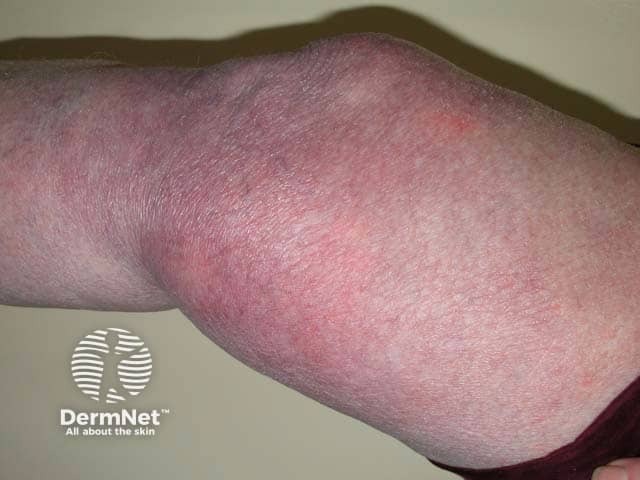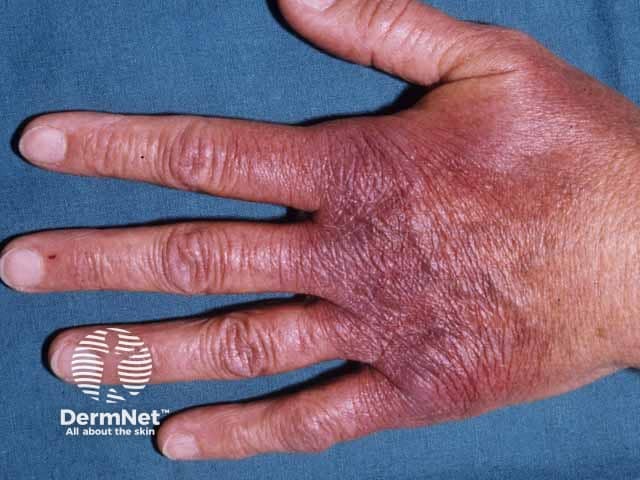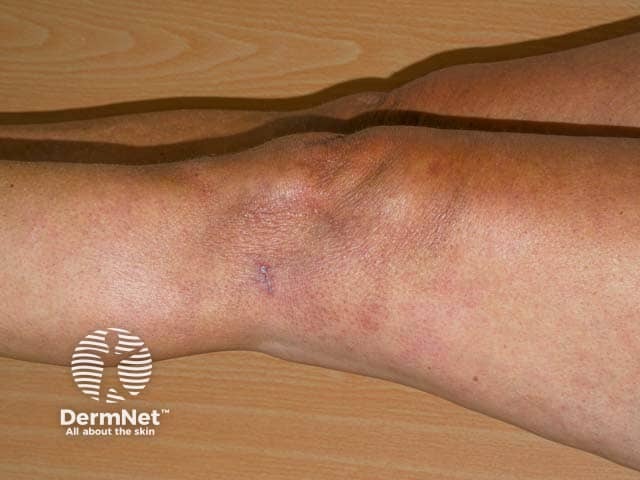Main menu
Common skin conditions

NEWS
Join DermNet PRO
Read more
Quick links
Acrodermatitis chronica atrophicans — extra information
Acrodermatitis chronica atrophicans
Author: Dr Daniela Vanousova, Dermatologist, Czech Republic; Chief Editor: Dr Amanda Oakley, Dermatologist, Hamilton, New Zealand, July 2015. DermNet Revision October 2021
Introduction Causes Demographics Clinical features Differential diagnoses Diagnosis Treatment Outcome
What is acrodermatitis chronica atrophicans?
Acrodermatitis chronica atrophicans (ACA) is the most common skin manifestation of the late stage of Lyme disease.
What causes acrodermatitis chronica atrophicans?
Acrodermatitis chronica atrophicans is caused by ongoing active skin infection by the bacteria Borrelia afzelii, found mostly in Europe. These bacteria are transmitted by a tick bite months or years before ACA develops.
Who gets acrodermatitis chronica atrophicans?
Acrodermatitis chronica atrophicans mostly affects middle-aged and older people, especially women. However, it can develop in anyone with untreated borrelial infection, including children. It is estimated that it arises in about 1–10% of people in Europe that have been infected with Lyme disease bacteria.
What are the clinical features of acrodermatitis chronica atrophicans?
Acrodermatitis chronica atrophicans typically presents as a unilateral violet discolouration of the extensor parts of the upper or lower limbs, especially the dorsum of the hand, elbow, instep, ankle, or knee. However, it can appear anywhere on the body and can be bilateral.
ACA develops in 2 stages. Initial inflammation is followed by progressive fibrosis and cutaneous atrophy over months or years.
- Inflammatory stage: ill-defined reddish discolouration and swelling of the affected area. The skin may be tender or painful.
- Atrophic stage: thin skin, loss of adnexal structures such as sweat glands, and hair, the disappearance of elastic fibres, and dilatation of blood vessels. Skin tears and ulcerates after minor trauma. The skin is described as tissue paper-like.
Less common features of ACA include fibrous papules and plaques, and skin coloured nodules.
Most patients have a history of tick bite. Some of them may recall a rash consistent with erythema migrans some months or years earlier, often affecting the same limb. Erythema migrans is a ring-like rash that occurs around the site of a Borrelia-infected tick bite. [see Erythema migrans images]

Inflammatory stage

Inflammatory stage

Atrophic stage
Are there systemic features in late-stage Lyme disease?
Acrodermatitis chronica migrans is a skin sign of the late stage of Lyme disease. Other features of late-stage Lyme disease in patients with ACA include:
- Neurological disorders—the most common
- Rheumatological symptoms
- Cardiovascular disease.
What is the differential diagnosis of acrodermatitis chronica atrophicans?
- Venous insufficiency or lipodermatosclerosis
- Thin skin due to ageing
- Erysipelas
- Erysipeloid
- Lichen sclerosus
- Morphoea (localised scleroderma)
- Systemic sclerosis
How is the diagnosis of acrodermatitis chronica atrophicans made?
Acrodermatitis chronica migrans is probably underdiagnosed. It is essential to obtain a detailed medical history and to determine whether there has been exposure to ticks (eg, being in grass or woodlands in endemic areas) or any previous manifestation of Lyme disease. When suspicious of ACA, a careful general skin examination should be carried out.
The diagnosis of ACA is confirmed on laboratory tests:
- Borrelia serology shows positive high IgG level in enzyme-linked immunosorbent assay (ELISA) and on Western blot. IgG antibodies can persist long-term, even after successful treatment for Lyme disease or ACA.
- Typical histological features of ACA on skin biopsy are dense perivascular lymphocytic infiltrate with plasma cells and mast cells, and dermal oedema; late stage shows epidermal atrophy, loss of adnexal structures (hair, eccrine glands), superficial sclerosis and fibroplasia. Spirochaetes may be seen with special stains.
- Borrelial infection in the skin can be confirmed by polymerase chain reaction (PCR).
How is acrodermatitis chronica atrophicans treated?
Prevention
There is no vaccine against Borellia so prevention is aimed at avoiding a tick bite or prompt removal of a tick if acquired.
- Avoid areas endemic for Lyme borreliosis.
- When walking in high grass or woodland, wear white clothes (so the tick can be seen more easily) with long sleeves, long trousers tucked into socks or long boots.
- Use repellents/insecticides.
- After returning from a walk in an endemic area, change your clothes and check your whole body carefully.
- The next day, check your body for ticks again.
- Remove the tick as prompt removal decreases the risk of Lyme disease transmission. Disinfect the site. Use tweezers to carefully and steadily pull the tick out from the skin. Disinfect the site again. Wash your hands.
- Watch the site of the tick bite for several weeks. If a rash appears bigger than 5 cm or you have 'flu-like symptoms, consult your doctor.
Specific measures
Acrodermatitis chronica atrophicans is treated with antibiotics. The choice of antibiotic and duration of treatment depends on which other organs are involved and the severity of symptoms. Antibiotics used for ACA may include:
- Doxycycline
- Cephalosporins: ceftriaxone, cefotaxime, cefuroxime axetil
- Penicillin G
- Amoxicillin
Patients with ACA may require referral to other specialists if there is extracutaneous organ involvement.
What is the outcome of acrodermatitis chronica atrophicans?
Acrodermatitis chronica atrophicans is most effectively treated in the early inflammatory stage when the skin changes are reversible. In the later atrophic stage, the infection can be eradicated, but skin changes persist.
Bibliography
- Flisiak I, Schwartz RA, Chodynicka B. Clinical features and specific immunological response to Borrelia afzelii in patients with acrodermatitis chronica atrophicans. J Med. 1999;30(3-4):267–78. PubMed
- Moniuszko-Malinowska A, Czupryna P, Dunaj J, et al. Acrodermatitis chronica atrophicans: various faces of the late form of Lyme borreliosis. Postepy Dermatol Alergol. 2018;35(5):490-4. doi:10.5114/ada.2018.77240 Journal
- Scott JD. Presentation of acrodermatitis chronica atrophicans rashes on Lyme disease patients in Canada. Healthcare (Basel). 2020;8(2):157. doi:10.3390/healthcare8020157 Journal
- Smetanick MT, Zellis SL, Ermolovich T. Acrodermatitis chronica atrophicans: a case report and review of the literature. Cutis. 2010 May;85(5):247–52. Review. PubMed
- Steere AC, Strle F, Wormser GP, et al. Lyme borreliosis. Nat Rev Dis Primers. 2016;2:16090. doi:10.1038/nrdp.2016.90 Journal
On DermNet
Other websites
- Acrodermatitis Chronica Atrophicans — Medscape Reference
